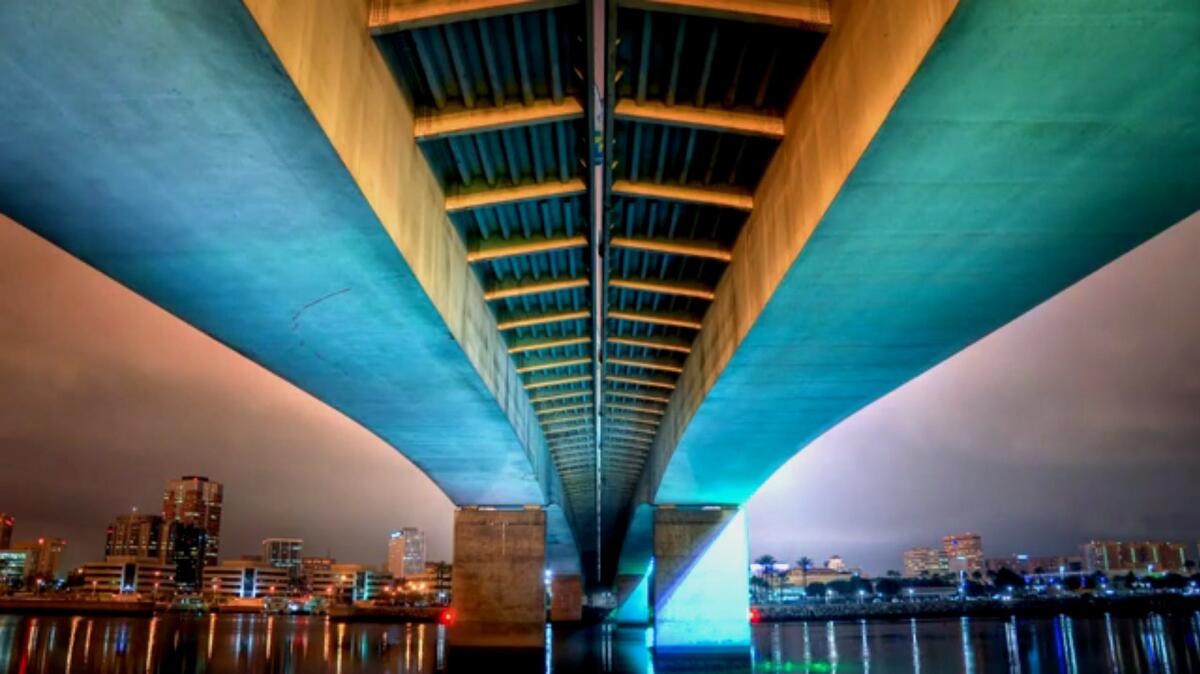Meditations on Southern California’s water lifeline

A detail of Peter Bo Rappmund’s “Psychohydrography” video (2010).
- Share via
California is not in danger of running out of water in the next year or two, but the climate-change situation is going from bad to worse as we enter the fourth year of drought. At Los Angeles Contemporary Exhibitions, “After the Aqueduct” looks at one big piece of the state’s water puzzle.
Organized by artist Kim Stringfellow, the show includes works by half a dozen artists and designers that focus on the century-old hydraulic water conveyance system meandering more than 200 miles from the Sierra Nevada to Southern California.
Six documentary photographs, individually uneventful, chosen from a larger series by Chad Ress lay it out: The sequence starts in the rugged mountain snowpack and ends in a swimming pool originally constructed for L.A.’s 1932 Summer Olympics. Isolated beauty morphs into communal fun.
Much of the display is documentary, such as a series of charts produced by Barry Lehrman and Cal Poly Pomona students – to date, more than 120 of them – who are mapping complicated land-use issues for the school’s Aqueduct Futures program. I would describe the charts as visually dry, although the pun threatens to distract from the seriousness of the task.
Machine drawings by landscape designer Alexander Robinson, director of the USC Landscape Morphologies Lab, are visually bland abstractions produced from topographical and other data. The most intriguing element is the machine, which looks like a castoff from a penny arcade.
The most idiosyncratic document comes from Lauren Bon, who rounded up 100 mules to make a 100-mile trek along a portion of the water route’s path. Mules were essential to building the aqueduct, and Bon refers to that in photographic murals, videos and props from her event.
But the best part is the video Bon shot from a small camera affixed to one mule’s bridle. A languid, slowly scanning mule’s-eye view of the journey unfolds. It’s funny, but it also has the disconcerting effect of reminding us that animals, after all, have lives too, and they rely on water. The point is simple but eloquently made, expanding the impact of the water problem.
“After the Aqueduct” approaches its subject from a variety of angles – physical, historical, social, political and mythic. The latter is at the core of a provocative video animation by Nicole Antebi, which concerns legends around Irish American aqueduct builder William Mulholland and uisce beatha – Irish for “the water of life.”
Mispronunciation of uisce is also the likely source of the English word whiskey. The animation might be suggesting that Mulholland was drunk on power, but it’s really hard to say. The audio was nearly impossible to hear, as too often happens with gallery installations of video.
That problem was less acute for “Psychohydrography,” a mesmerizing video by Peter Bo Rappmund. The ambient sound simply meshes with regular gallery noise.
It’s a spellbinding visual excursion, an hourlong sequence of stationary, time-lapse views of water’s journey from the mountains to the sea. The travelogue has been screened in a variety of university and museum settings since 2010 and is the singular standout here.
The compression of time intensifies the imagery’s color and texture as we travel from day to night, rural to urban, and make stops almost everywhere in between.
Rappmund isn’t merely aestheticizing sludge and ruin, putting lipstick on a pig. For instance, when he arrives at the Pacific Ocean, the compressed striations of lapping waves suggest the agitated vertical and horizontal controls on a misfiring television screen. An orange sunset seems suddenly toxic.
At once familiar and alien, mundane and otherworldly, lovely and acidic, “Psychohydrography” is an epic example of art’s power to seduce. A viewer might wonder, “What is this strange and beautiful and haunted place?” Given our burgeoning water crisis, it’s an inquiry worth making.
Twitter: @KnightLAT
LACE, 6522 Hollywood Blvd., (323) 957-1777, through April 12. Closed Mondays and Tuesdays. www.welcometolace.org
More to Read
The biggest entertainment stories
Get our big stories about Hollywood, film, television, music, arts, culture and more right in your inbox as soon as they publish.
You may occasionally receive promotional content from the Los Angeles Times.











